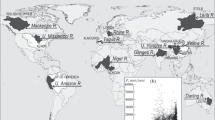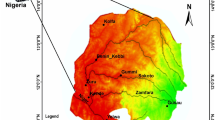Abstract
By using the Arctic runoff data from R-ArcticNET V4.0 and ArcticRIMS, trends of four major rivers flowing into the Arctic Ocean, whose climate factor plays an important role in determining the variability of the Arctic runoff, are investigated. The results show that for the past 30 years, the trend of the Arctic runoff is seasonally dependent. There is a significant trend in spring and winter and a significant decreasing trend in summer, leading to the reduced seasonal cycle. In spring, surface air temperature is the dominant factor influencing the four rivers. In summer, precipitation is the most important factor for Lena and Mackenzie, while snow cover is the most important factor for Yenisei and Ob. For Mackenzie, atmospheric circulation does play an important role for all the seasons, which is not the case for the Eurasian rivers. The authors further discuss the relationships between the Arctic runoff and sea ice. Significant negative correlation is found at the mouth of the rivers into the Arctic Ocean in spring, while significant positive correlation is observed just at the north of the mouths of the rivers into the Arctic in summer. In addition, each river has different relationship with sea ice in the eastern Greenland Sea.
Similar content being viewed by others
References
Aagaard K, Carmack E C. 1989. The role of sea ice and other freshwater in the Arctic circulation. J Geophys Res, 94: 14485–14498
Aagaard K, Woodgate R A. 2001. Some thoughts on the freezing and melting of sea ice and their effects on the ocean. Ocean Modelling, 3: 127–135
Aaggaard K, Coachman L K, Carmack E. 1981. On the halocline of the Arctic Ocean. Deep-Sea Research, 28: 529–545
Arnell N W. 2005. Implication of climate change for freshwater inflows to the Arctic Ocean. J Geophys Res, 110, D07105, doi:10.1029/2004JD005348
Barry R G, Serreze M C. 2000. Atmospheric components of the Arctic Ocean freshwater balance and their interannual variability. The freshwater budget of the Arctic Ocean, 45–56
Bruce J P, Robert M H, James W M. 2002. Increasing River Discharge to the Arctic Ocean. Science, 298: 2171–2173
Comiso J C. 2006. Abrupt decline in the Arctic winter sea ice cover, GRL, v33, L18504, doi: 10.1029/2006GL027341
Daqing Yang, Douglas L K, Larry D H, et al. 2002. Siberian Lena River hydrologic regime and recent change. J G R, 107(D23) 4694, doi: 10.1029/2002JD002542
Erik Stokstad. 2002. River flow could derail crucial ocean current. Science, Doi: 10.1126/science. 1077445
Gao Guoping, Zhao Jingping, Dong Zhaoqian, et al. 2004. Distribution and variation of temperature and salinity around the Bering Strait. Polar Research(in Chinese), 16(3): 229–239
Grabs W E, Portmann F. 2000. Discharge observation networks in arctic regions: computation of the river runoff into the Arctic Ocean, its seasonality and variability. The Freshwater Budget of the Arctic Ocean, 249–267
Hassol S J. 2004. Impacts of a Warming Arctic: Arctic Climate Impact Assessment, 139. New York: Cambridge Univ Press
Huang Jia-you. 2004. Application of statistic to weather forecast. Beijing China Meteorological Press
Jennifer, A F, Elias H. 2007. Drivers of declining sea ice in the Arctic winter: A tale of two seas. G R L, 34, L17503, doi: 10.1029/2007GL030995
Jones E P. 2008. Circulation in the Arctic Ocean. Polar Research, 20(2): 139–146
Lubinskia D J, Polyakb L, Forman S L. 2008. Freshwater and Atlantic water inflows to the deep northern Barents and Kara seas since ca 13 14Cka: foraminifera and stable isotopes. Quaternary Science Reviews, 20: 1851–1879
Otter O H, Drange H. 2004. A possible feedback mechanism involving the arctic freshwater, the Arctic sea ice, and the north Atlantic drift. Advances in Atmospheric Sciences, 21(5): 784–801
Rothrock D A, Yu Y, Maykut G A. 1999. Thinning of the arctic sea-ice cover. G R L, 26: 3469–3472
Semiletov I P, Savelieva N I. 2000. The dispersion of Siberian river flows into coastal waters: Meteorological, hydrological and hydro-chemical aspects. The Freshwater Budget of the Arctic Ocean, 323-366
Serreze M C, Andrew P B, Andrew R G, et al. 2006. The large-scale freshwater cycle of the Arctic. J Geophys Res, C11010, doi: 10.1029/2005JC003424
Shi Jiuxin, Zhao Jinping. 2003. Advances in studies on the arctic halocline. Advances in Earth Science(in Chinese), 18(3): 351–357
Shiklomanov I A, Lammers R B, Peterson B J. 2000. The dynamics of river water inflow to the Arctic Ocean. The Freshwater Budget of the Arctic Ocean, 281-296
Stroeve J C, Fetterer F. 2005. Tracking the Arctic’s shrinking ice cover: Another Extreme Minimum in 2004, GRL, Vol.32, L04501, doi:10.1029/2004GL021810
Sui Cuijuan, Zhang Zhanhai, Liu Jiping. 2008. Variation of Arctic runoff and its association with climate factors. Acta Oceanologica Sinica(in Chinese), 30(4): 39–47
Yang D Q, Ye B S, Douglas L K. 2004. Stream flow changes over Siberian Yenisei River Basin. Journal of Hydrology, 296: 59–80
Yang Daqing, Douglas L Kane. 2002. Siberian Lena river hydrologic regime and recent change. J G R, v 107, n D23
Zhang Jinlun, Lindsay Ron, Steele Mike, et al. 2008. What drove the dramatic retreat of arctic sea ice during summer 2007? G R L, v35, L11505, doi:10.1029/2008GL034005
Author information
Authors and Affiliations
Corresponding author
Additional information
Foundation item: The National Natural Science Foundation of China under contract Nos 40676003 and 40876099; the National Basic Research Program of China under contract No. 2006CB403605; “Hundred Talent Program” of the Chinese Academy of Sciences, the China Meteorological Administration under contract No. GYHY200806006; the National Key Technology R&D Program under contract No. 2008AA121704.
Rights and permissions
About this article
Cite this article
Li, P., Zhang, Z. & Liu, J. Dominant climate factors influencing the Arctic runoff and association between the Arctic runoff and sea ice. Acta Oceanol. Sin. 29, 10–20 (2010). https://doi.org/10.1007/s13131-010-0058-3
Received:
Accepted:
Published:
Issue Date:
DOI: https://doi.org/10.1007/s13131-010-0058-3




